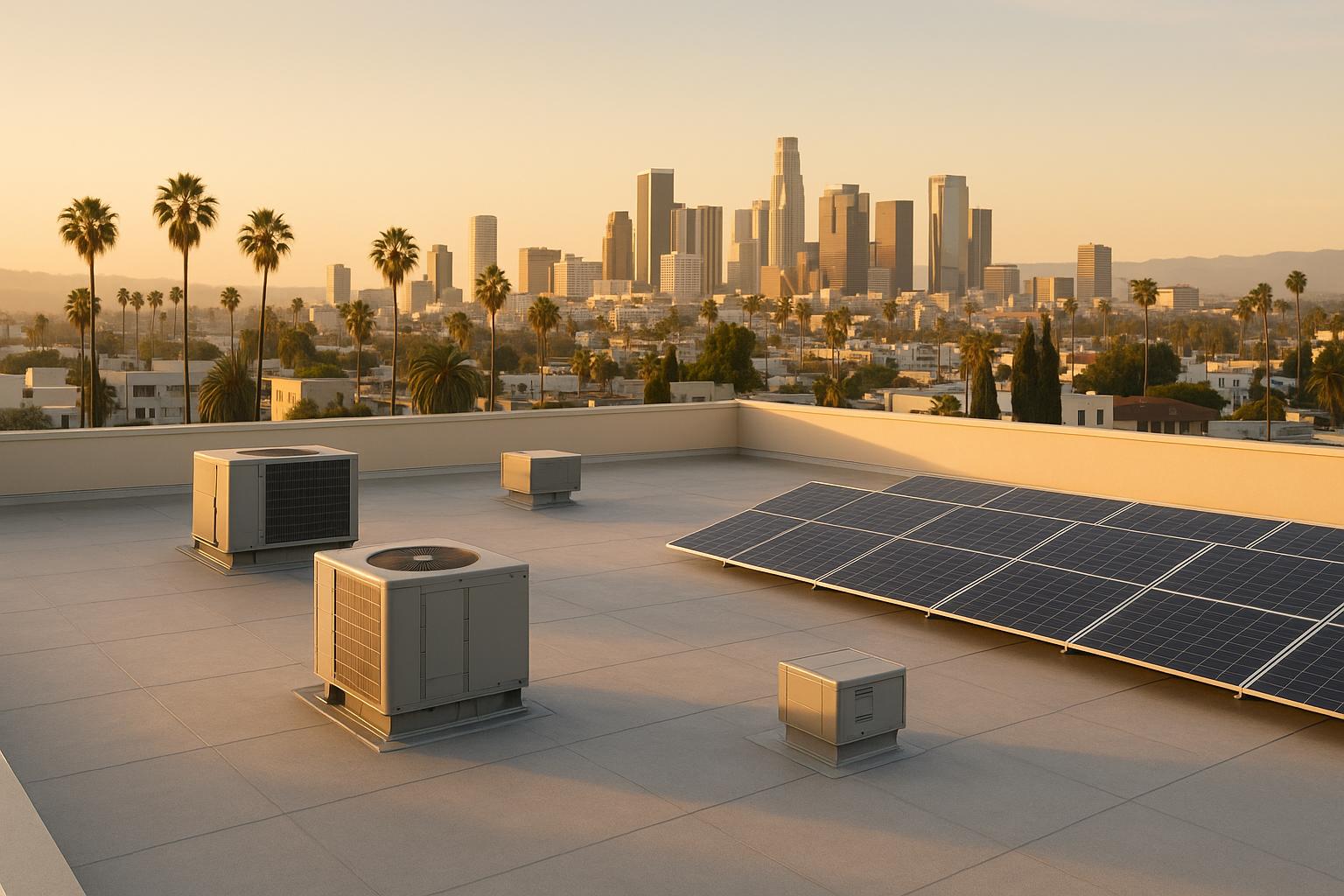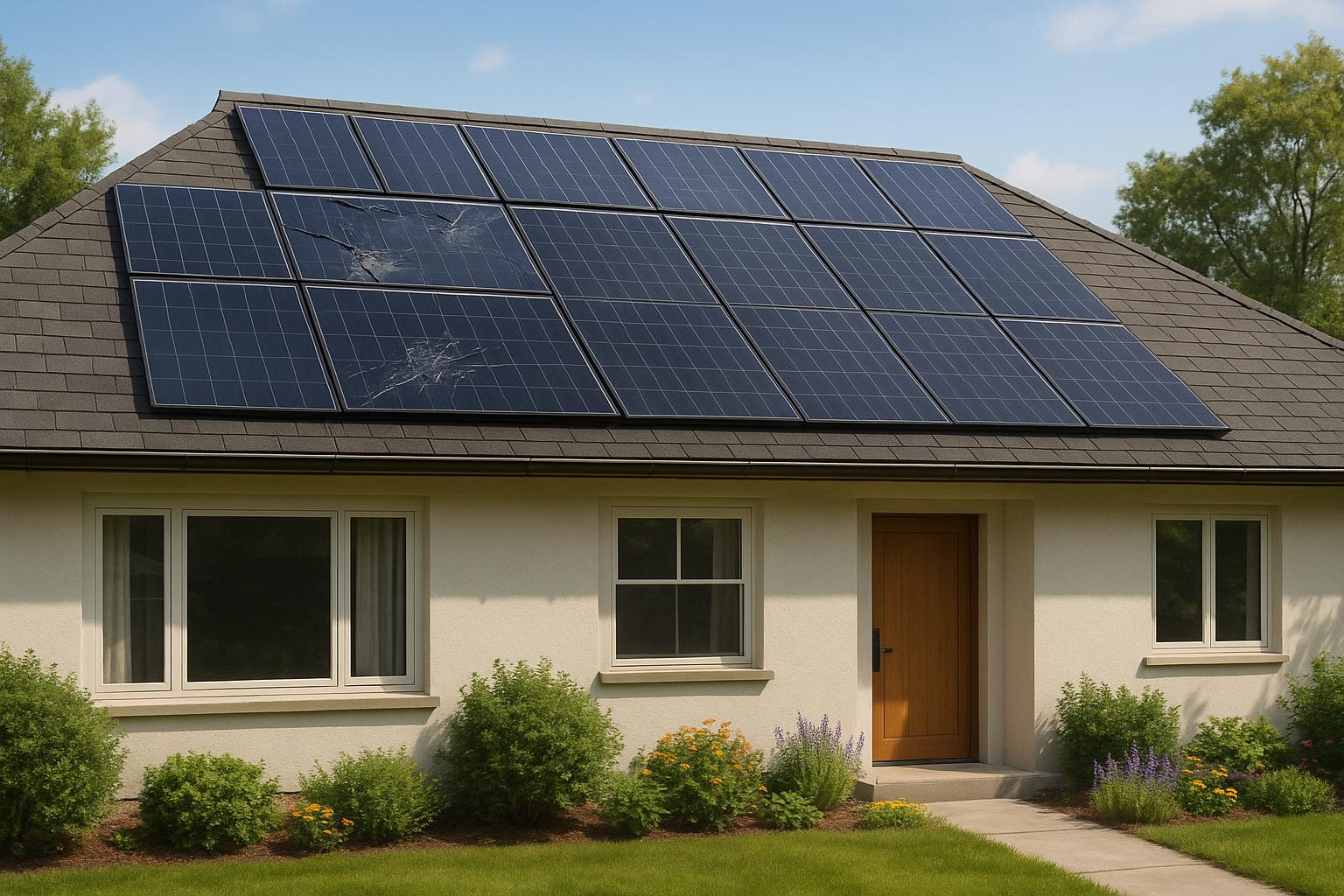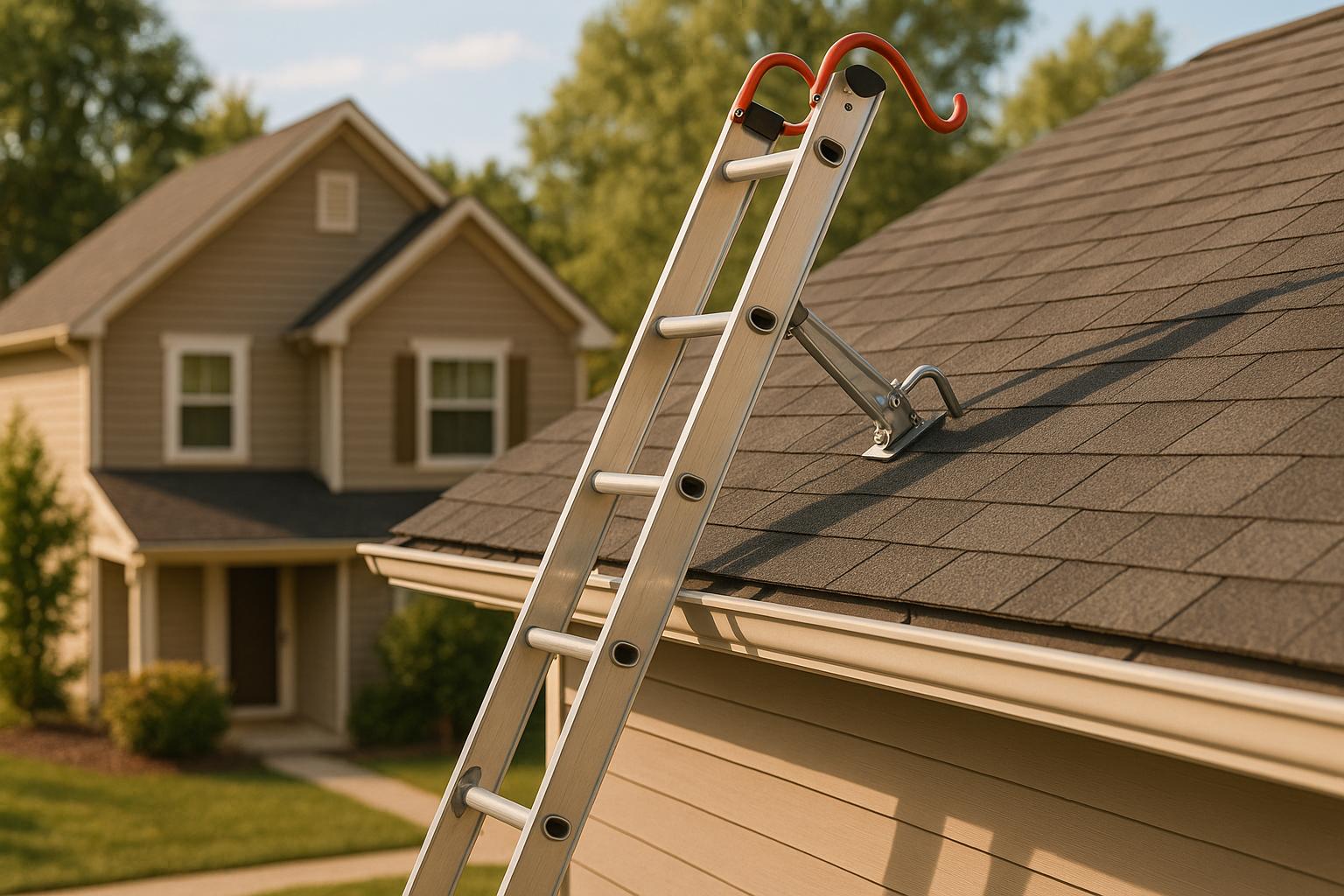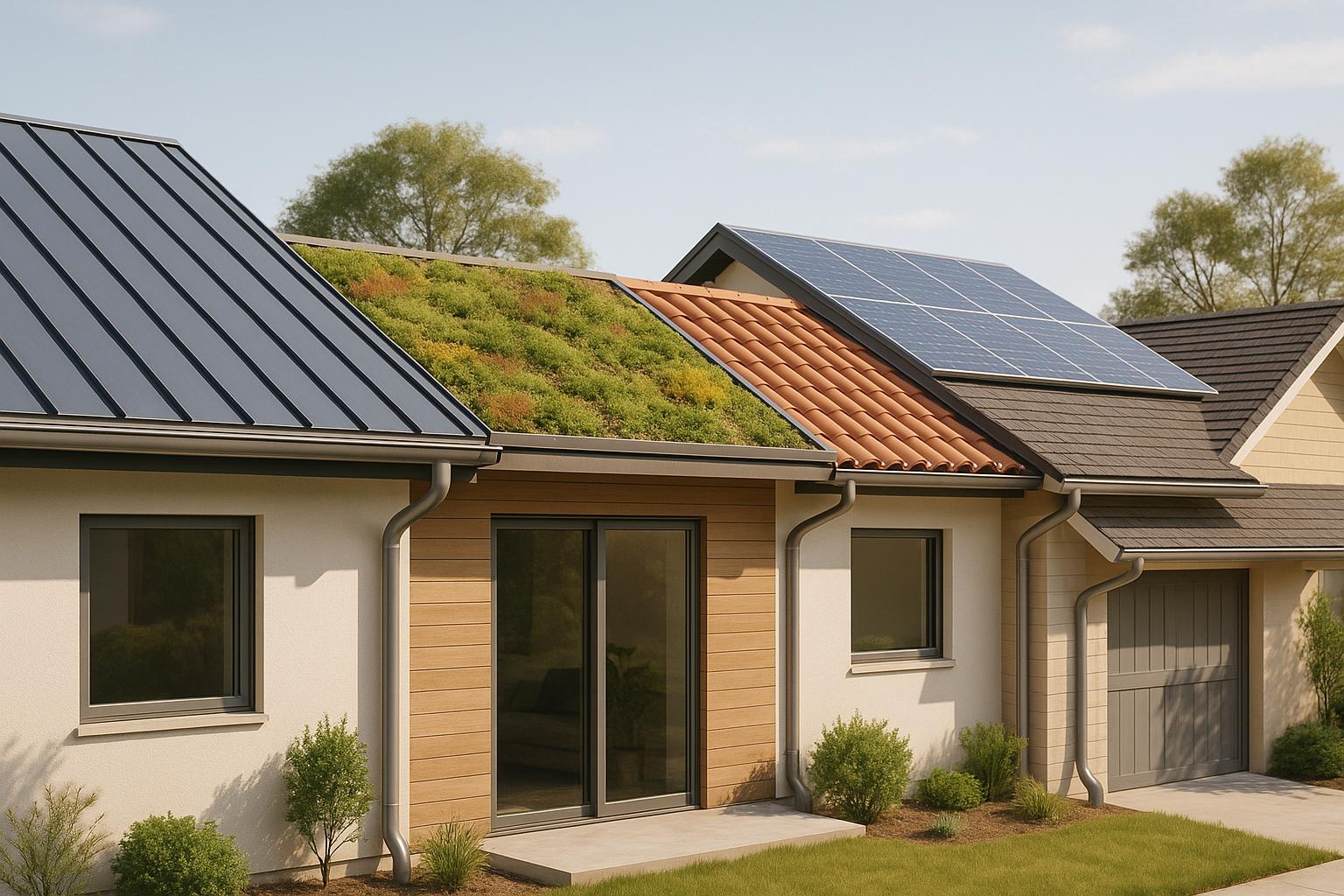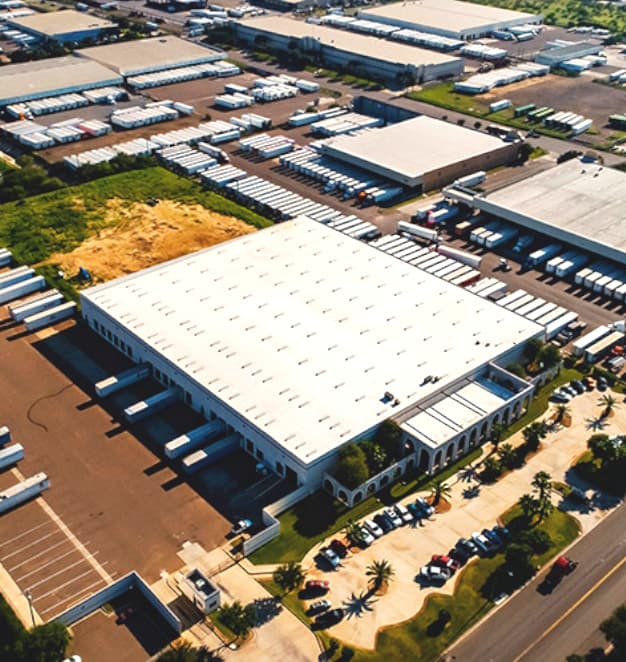In Los Angeles, commercial roofs last between 10 and 40 years, depending on the material, installation quality, and maintenance. Factors like intense sunlight, temperature swings, air pollution, and Santa Ana winds can shorten their lifespan. Here’s a quick breakdown of popular roofing materials and their durability:
- Metal Roofing: 40–70 years, long-lasting but higher upfront cost.
- PVC Roofing: Up to 30 years, durable but expensive.
- EPDM (Rubber): 25–30 years, affordable but prone to punctures.
- TPO: 20–30 years, energy-efficient but requires UV protection.
- Modified Bitumen: 20–25 years, durable but less eco-friendly.
- Flat Roofs: 15–30 years, needs proper drainage to avoid damage.
Quick Tips to Extend Roof Lifespan:
- Inspect your roof twice a year (spring and fall).
- Clear debris, unclog gutters, and fix minor damage early.
- Consider cool roof technology to reduce heat stress and save energy.
- Hire professionals for installation and repairs to ensure durability.
Proper maintenance can extend your roof’s life by years and prevent costly replacements.
Maximizing Roof Lifespan: Repair or Replace? | Commercial Roofing Guide
Common Commercial Roofing Materials in LA
When it comes to commercial roofing in Los Angeles, property owners have a variety of options tailored to the region’s climate. Each material has its own strengths and weaknesses, making the choice an important one for long-term durability and performance.
Popular Materials Overview
The most widely used commercial roofing materials in Los Angeles include Modified Bitumen, TPO, PVC, Built-Up Roofing (BUR), EPDM, and Metal Roofing. These options are favored for their ability to withstand LA’s environmental conditions while offering durability and energy efficiency.
Flat roofing systems have gained popularity in the city, thanks to their modern appearance and compatibility with LA’s building designs. Meanwhile, metal roofing is becoming a top choice due to its long lifespan and eco-friendly properties. The demand for single-ply roofing membranes is also surging, with the market projected to grow at a 9% annual rate from 2024 to 2029.
Here’s a closer look at how these materials perform in LA’s climate.
Durability and Features of Each Material
Choosing the right roofing material means understanding how it holds up in Southern California’s weather and meeting the specific needs of your property.
Modified Bitumen offers multi-layer protection, making it ideal for roofs with heavy foot traffic. It’s durable and relatively easy to install. However, it lacks design flexibility, is prone to punctures, and isn’t as environmentally friendly as newer options.
TPO (Thermoplastic Polyolefin) is known for its energy efficiency and reflective properties, making it a great fit for LA’s sunny climate. With a lifespan of 15–20 years, it’s also a budget-friendly choice.
PVC Roofing is highly resistant to chemicals and fire, enabling it to handle harsh winds and extreme weather. It can last up to 30 years. While it’s one of the pricier single-ply options, its durability is a major advantage. Drawbacks include higher upfront costs, reduced performance in very high temperatures, and more complex repairs.
Built-Up Roofing (BUR) has been a reliable option for decades. It’s durable, cost-effective, easy to repair, and fire-resistant. However, BUR systems are heavy, have shorter lifespans compared to newer materials, and can emit odors during installation.
EPDM Roofing is an affordable option with a lifespan of up to 30 years when well-maintained. It excels in weather resistance but offers limited color choices and is more susceptible to punctures.
Metal Roofing stands out with a lifespan of 40 to 70 years when properly maintained. It reflects solar heat, resists fire, rot, and pests, and is fully recyclable. While the initial cost is higher, metal roofs deliver excellent long-term value.
For property owners in Los Angeles, the decision often hinges on balancing upfront costs with long-term performance. Compliance with California Title 24 energy standards is another critical factor to consider. It’s also wise to get a professional roof inspection to evaluate existing conditions and any design constraints before making a final choice.
Selecting the right material ensures your roof can handle LA’s unique climate challenges while meeting your building’s needs.
Average Lifespan of Commercial Roofing Materials
Understanding how long your commercial roof is likely to last is crucial for planning and budgeting. Studies reveal that in Southern California, a roof’s lifespan depends significantly on the type of material, the local climate, and how well it’s maintained. Neglecting maintenance or dealing with poor installation can drastically shorten a roof’s life, sometimes by half.
Material Lifespan Comparison Table
Here’s a quick breakdown of common commercial roofing materials and their expected lifespans under Los Angeles conditions:
| Material | Lifespan | Maintenance Requirements | Common Problems |
|---|---|---|---|
| EPDM (Rubber) | 25–30 years | Regular inspections for punctures | Seam failures, shrinkage |
| TPO | 20–30 years | UV protection monitoring | Heat welding issues, membrane cracking |
| Modified Bitumen | 20–25 years | Surface coating renewal | Thermal expansion, cracking |
| Metal Roofing | 40+ years | Fastener and coating checks | Corrosion at joints, thermal movement |
| Flat Roofs (General) | 15–30 years | Proper drainage and regular inspections | Water damage |
This table underscores how much material choice and environmental conditions can influence roof longevity. For instance, metal roofing stands out for its impressive lifespan of 40–70 years, making it a long-term investment despite its higher initial cost.
Single-ply membranes like TPO and EPDM offer a moderate lifespan, with TPO typically lasting 20–30 years and EPDM slightly edging ahead at 25–30 years. Meanwhile, modified bitumen systems provide a solid 20–25 years of service, offering a reliable mid-range option for many commercial buildings.
Factors That Affect Lifespan in LA
Los Angeles’ climate poses unique challenges that can significantly impact a roof’s durability. The region’s intense sun and wide daily temperature swings speed up material aging. Add to that air pollution, occasional hail, and chemical pollutants, and you’ve got a mix that can wear down roofing materials faster than in other regions.
Pollutants in LA’s air can cause corrosion, while dust and debris often clog drainage systems, increasing stress on the roof. Additionally, flat roofs are particularly vulnerable to water damage if proper drainage isn’t maintained.
Cool roofs, designed to reflect sunlight, can help combat these challenges by reducing surface temperatures by as much as 50°F, which minimizes thermal stress and slows material aging. However, the key to maximizing any roof’s lifespan lies in professional installation and consistent upkeep.
"A consistent maintenance program can extend the functional life of your roof by years, delaying the substantial cost of a full replacement."
sbb-itb-d1d6490
How to Make Your Roof Last Longer
Taking care of your roof can significantly extend its lifespan – often from 13 to 21 years. Interestingly, over 80% of premature roof replacements stem from issues that could have been avoided with proper maintenance. In Los Angeles, where environmental factors like heat and occasional heavy rain take their toll, consistent and smart upkeep is key to protecting your investment.
Regular Inspections and Maintenance
The secret to a long-lasting roof is catching problems early. Aim to inspect your roof twice a year – once in the spring to address winter damage and again in the fall to prepare for LA’s summer heat.
During inspections, pay close attention to vulnerable areas such as seams, flashings, and penetrations. Watch for ponding water, which can signal drainage problems that might lead to structural damage.
Preventative maintenance is not just smart – it’s cost-effective. It can save about 11 cents per square foot annually. Simple tasks like clearing debris, keeping gutters unclogged, and trimming overhanging branches can prevent ponding water and reduce the risk of mold. Also, keeping detailed records of all roof activity – who accessed it, when, and why – can help track its condition over time.
Professional Installation and Repairs
While regular maintenance is essential, proper installation lays the groundwork for a roof that can withstand LA’s challenging climate. A professionally installed roof adheres to building codes and manufacturer guidelines, ensuring materials perform as intended and warranties remain valid.
"The precision necessary for weather tightness and durability can only be guaranteed through professional installation, resulting in a formidable defense against the elements." – HP Roofing Pro
In a city like Los Angeles, where intense sunlight, temperature swings, and sporadic heavy rains are common, professional installation becomes even more critical. Expert roofers understand how these conditions affect different materials and can adapt their techniques accordingly.
Addressing repairs promptly is equally important. Even seemingly minor damage can escalate quickly in LA’s harsh environment. Companies like Prime American Roofing focus on catching and fixing these issues early, using high-quality materials designed to handle Southern California’s unique challenges.
Professional contractors also ensure proper drainage and ventilation systems are in place, which are crucial for preventing water damage and reducing thermal stress on roofing materials.
Reflective Coatings and Cool Roof Options
Adding advanced solutions like reflective coatings or cool roofs can further extend your roof’s life. Cool roofing technology, for instance, offers significant benefits in Los Angeles. By reflecting over 50% of solar energy, cool roofs can lower surface temperatures by about 50°F on sunny days, reducing the thermal shock that ages materials prematurely.
Dark roofs, which absorb up to 90% of solar energy, can’t compete with cool roofs when it comes to longevity. In fact, cool roofs can add 5–10 years to the lifespan of traditional roofing materials. They also deliver energy savings, cutting cooling costs by 15–30% and easing the strain on HVAC systems. For non-air-conditioned buildings, cool roofs can lower indoor temperatures by 2.2 to 5.9°F.
Advanced coatings like Super Therm® go even further, blocking 96.1% of total solar heat and reducing sound transmission by 68%. In Los Angeles, widespread adoption of cool roofs could save millions annually in energy costs while also improving air quality.
"A reflective roof and a reflective wall are very simple and reliable passive strategies that don’t require you to do anything other than make the right choice when it comes time to re-roof or re-paint. It will help you now and it’ll be even more useful as the climate warms." – Ronnen Levinson, cool materials scientist at the Lawrence Berkeley National Laboratory
To maximize the benefits of cool roofs, inspect them regularly for damage, clean off dirt and debris, and reapply coatings as needed. Choose materials with high solar reflectance and thermal emittance that suit your roof type, and pair them with quality insulation for better temperature control year-round.
Conclusion
After exploring material performance and maintenance strategies, here are some final thoughts for property owners in Los Angeles. Studies reveal that commercial roofs in LA can last anywhere from 10 to 100 years, depending on the material and upkeep. For instance, tile roofs can endure up to a century, while flat roofs often need replacement every 15–20 years.
Routine maintenance plays a critical role in extending a roof’s lifespan. With proper care, most roofing systems can last 30–40 years, but neglect can cut that time significantly. Additionally, a well-maintained roof can boost property value by as much as 10%.
Key Points for LA Property Owners
For property owners in Los Angeles, keeping these points in mind is essential:
- Select materials that suit your location. Coastal areas deal with moisture and salt exposure, while inland properties face intense heat cycles. Tile roofs, though long-lasting, require a sturdy structure to support their weight.
- Hire professionals for installation and maintenance. Many roofing manufacturers include maintenance requirements in their warranty terms, and skipping these could void your coverage. Local contractors are familiar with building codes and climate-specific techniques, ensuring your roof performs as intended.
- Stick to bi-annual inspections. Schedule inspections in spring and fall to address issues like membrane tears, blocked drains, or flashing separation before they escalate. Early detection can prevent costly damage and help you avoid sudden, large expenses.
Prime American Roofing specializes in tailored roofing solutions for Southern California’s unique climate. Their expertise in installation and maintenance ensures your roof lasts as long as possible.
FAQs
What factors affect how long commercial roofs last in Los Angeles?
The lifespan of commercial roofs in Los Angeles hinges on a few important factors: local weather patterns, the roofing materials used, the installation quality, and consistent maintenance efforts. With the city’s intense sunlight, high temperatures, occasional heavy rains, and strong winds, roofs face a fair share of challenges that can lead to gradual wear and tear.
To help your roof last longer, focus on choosing sturdy materials, maintaining proper ventilation and drainage systems, and scheduling routine inspections and upkeep. Professional installation is equally important, ensuring your roof can handle Los Angeles’ demanding climate effectively.
How does the type of roofing material affect energy efficiency and sustainability in Los Angeles?
The type of roofing material you pick can greatly influence energy efficiency and environmental impact, especially in Los Angeles, where sunshine is abundant. Cool roofing materials, such as reflective coatings or white membranes, are designed to reflect sunlight rather than absorb it. This helps keep your building cooler, reducing the need for air conditioning and cutting down on energy bills.
If you’re looking for a greener choice, consider options like metal roofs made from recycled materials or green roofs covered with plants and vegetation. These not only minimize environmental impact but also provide natural insulation, helping to conserve energy while promoting a healthier ecosystem. Choosing a roofing material suited to LA’s sunny climate can benefit both your property and the environment.
What are the best maintenance tips to increase the lifespan of commercial roofs in Los Angeles?
To keep commercial roofs in Los Angeles in great shape for as long as possible, consistent upkeep is essential. Begin by setting up regular cleanings to clear away debris, moss, and algae – these can wear down your roof faster than you’d expect. Scheduling twice-a-year inspections is another smart move. These help identify and fix small problems, like damaged flashing, clogged drains, or minor leaks, before they turn into expensive repairs.
It’s also important to ensure proper drainage to avoid water pooling, especially during LA’s occasional heavy rainstorms. And with the city’s intense sunshine and unpredictable weather shifts, inspecting your roof after extreme conditions is a good habit to adopt. A maintenance plan that considers LA’s unique climate can go a long way in boosting your roof’s longevity and performance.

